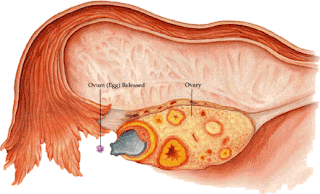Ovulation
For those who are still unsure of the process, here is a scientific explanation of how a baby is made. In a woman’s body, each month about
30 immature eggs will develop in small follicles. At about the 9th day of the
menstrual cycle, one of the follicles will become the dominant follicle and it
will suppress the growth of other follicles. The dominant follicle will mature
on the 14th day, rupture and release the egg from the ovary. This process is
called ovulation. The egg that is released is swept into the fallopian tube, where fertilisation will take place. The egg can be fertilised for 24
hours after ovulation. So sexual intercourse should be done with 24 hours after
ovulation in order for the fertilisation to take place.
These are the signs and symptoms that may suggest ovulation is occuring:
These are the signs and symptoms that may suggest ovulation is occuring:
·
Increase in cervical mucus which is thin and
stretchable.
·
Pain due to rupturing of the mature follicle.
·
Rise and fall of oestrogen levels.
·
Breast tenderness due to progesterone stimulation.
·
Increase in basal body temperature due to rise
of progesterone levels
Fertilization
The sperm will travel from the
vagina through the cervical canal, up to the uterus and into the fallopian
tubes. Fertilization usually occurs in the ampula (the swelling end) of the
tubes. The egg is covered by zona pellucida (egg-shell) and on it are receptors
for the sperm to attach and fertilise it. The sperm will penetrate the zona
pellucida through these receptors , fertilise the egg and together form the
zygote. After one sperm has entered the egg, the zona pellucida will be
depolarized (the shell will harden) to prevent other sperm from entering. So, only 1 sperm can
fertilize an egg. After fertilization, the zygote (fertilised egg) will travel along
the tube towards the uterus, due to the wave movements of the fimbriae and
cilia. During its travel to the uterus, zygote will undergo cell divisions and
differentiation.
Implantation and Pregnancy
After 24-hours of fertilization,
the zygote will divide into two cells, then four cells, then eight cells. On
the fifth day, the embryo will become a blastocyst (70-100 cells) and reach the
uterine cavity. Just before implantation the cells of the blastocyst have to
hatch out of the zona pellucida (a hole in the zona pellucida for the cells to
come out). The blastocyst will usually implant on the posterior uterine wall.
There may be a spot of bleeding when the blastocyst penetrates then
endometrium. The cells in the blastocyst will continue to divide and
differentiate to form inner cell mass (future foetus), trophoblast (future
placenta) and amnotic sac. The trophoblast will produce progesterone which is
essential for the embryo to grow and develop at the implantational site. It
also produces hCG which can be detected in the woman’s blood after 10 days of
fertilisation or in the urine after 14 days of fertilsation. 3 weeks after
fertilisation, the amniotic sac can be detected using ultrasound scan. So there it is, the precious baby you've sooo been longing for!
Here's a video of the ovulation-fertilization-implantation-menstruation process, except that we don't want the menstruation part. We want the embryo to stay embedded in the uterine lining and grow into a healthy foetus and come into the world some 9 months later :)
Here's a video of the ovulation-fertilization-implantation-menstruation process, except that we don't want the menstruation part. We want the embryo to stay embedded in the uterine lining and grow into a healthy foetus and come into the world some 9 months later :)



No comments:
Post a Comment